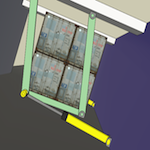Please find below the
Finalist Evaluation
Judges'' ratings
| • | Novelty: | |
| • | Feasibility: | |
| • | Impact: | |
| • | Presentation: |
Judges'' comments
It seems that the author has spent quite some time on this imaginative proposal. However, I am concerned about the complexity of the suspension system, having to carry enormous loads, and its maintenance along with the cost implications. I would also be more cautious about the potential gain of wave energy and how it translates into propulsion power--it is not clear where the numbers are coming from. While elegant on paper, it may turn out to be impracticable.
The concept is very interesting but I still believe freight hauling is probably not the best market to start with. Marine freight hauling is dependent on reliable delivery times and huge capacities. Even so, I could see a market for something that can operate for long periods with little fuel and isn't nuclear powered. For example automated drone ships for data collection would interesting, the roll-propulsion system would allow them to operate for extreme periods and long-distances. Coupled with solar power to supplement electronics and I could see this used by NOAA if the propulsion system works out. There are many issues with the concept and the authors identified and addressed many of them. The most obvious question is “what about when the waves are small or in the wrong direction. The authors did a nice job addressing the issues but there will still be times where the wave energy is low. Even so, the demonstration of a wave powered vessel would indeed make a very interesting project for a research institution.
It is not entirely clear if the calculations reflect actually the real situation in a ship. Also, in the beginning it is mentioned that suspending containers by 1mm moves the center of gravity from G1 to G - this is unclear.
Interesting proposal of a novel concept and a lot of work has gone into it.To this reviewer, the modification of existing ships does not seem to make sense but the construction of a purpose build tug/barge system might. The proposal would gain significantly if tied to a wind based kite system as well to increase the speed.The economic feasibility of the system based on existing trade (for containerized trade might be too slow but for bulk material might be easier) needs to be studied further. More importantly, the technical problems of hanging such a weight from the top structure of a tug would need to be considered (and their costs).Seems worth further investigation.
The proposal is innovative, interesting and imaginative, even if not always clear. Unfortunately, as the same authors acknowledge, a number of problems arise which limit their real effectiveness and make it economical unfeasible. Moreover, the amortization costs of the vessels seem not to be considered by the authors in their economic feasibility study which, in fact, are crucial: for shipping companies, the real problem in the slow steaming is the need of more vessels to perform the same services. On the other hand, CO2 emission represents a cost for the society and its reduction should be considered in a proper economic feasibility study. Therefore, I would encourage the authors to make a more proper economic feasibility study including these two main aspects. This would make this proposal more understandable in terms of potential impacts and comparable with other proposals also increasing the final user costs like the cap and trade actions.
Semi-Finalist Evaluation
Judges'' ratings
| • | Novelty: | |
| • | Feasibility: | |
| • | Impact: | |
| • | Presentation: |
Judges'' comments
The concept is very interesting but freight hauling is probably not the best market. Marine freight hauling is dependent on reliable delivery times and huge capacities. There are many issues with the concept and the authors identified many of them. The most obvious question is “what about when the waves are small or in the wrong direction.” Wind power has similar issues where the wind doesn’t always blow strong enough or is too strong. At least a windmill can turn into the wind. This concept doesn’t have that opportunity since the ship has to travel to a set destination. The demonstration of a wave powered vessel would indeed make a very interesting project for a research institution.
No comments have been posted.
